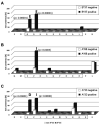Sequence diversity of hepatitis D virus in Mongolia
- PMID: 37035318
- PMCID: PMC10077969
- DOI: 10.3389/fmed.2023.1108543
Sequence diversity of hepatitis D virus in Mongolia
Abstract
Introduction: The Hepatitis Delta Virus (HDV) is a defective, single-stranded RNA virusoid encoding for a single protein, the Hepatitis Delta Antigen (HDAg), which requires the hepatitis B virus (HBV) envelope protein (HBsAg) for its transmission. Currently, hepatitis D is the most aggressive form of viral hepatitis and treatment options are limited. Worldwide 12 million people are chronically infected with HDV being at high risk for progression to cirrhosis and development of liver cancer.
Objectives: Although it is well established that Mongolia is the country with the highest prevalence of HDV infections, the information on the molecular epidemiology and factors contributing to HDV sequence diversity are largely unclear. The aim of the study was to characterize the sequence diversity of HDV in rural areas from Mongolia and to determine the extent of HLA class I-associated selection pressure.
Patients and methods: From the HepMongolia cohort from rural areas in Mongolia, 451 HBsAg-positive individuals were selected and anti-HDV, HDV-RNA and the sequence of the large HDAg was determined. For all individuals the HLA class I locus was genotyped. Residues under selection pressure in the presence of individual HLA class I types were identified with the recently published analysis tool HAMdetector.
Results: Of 431 HBsAg positive patients, 281 were anti-HDV positive (65%), and HDV-RNA could be detected in 207 of 281 (74%) of patients. The complete large HDAg was successfully sequenced from 131 samples. Phylogenetic analysis revealed that all Mongolian HDV isolates belong to genotype 1, however, they separate into several different clusters without clear regional association. In turn, from phylogeny there is strong evidence for recent local transmission events. Importantly, we found multiple residues with strong support for HLA class I-associated selection pressure consistent with a functional CD8+ T cell response directed against HDV.
Conclusion: HDV isolates from Mongolia are highly diverse. The molecular epidemiology suggests circulation of multiple subtypes and provides evidence for ongoing recent transmissions.
Keywords: HDV subtypes; HLA class I-associated selection pressure; Mongolia; hepatitis D virus; molecular epidemiology; sequence diversity.
Copyright © 2023 Magvan, Kloeble, Ptok, Hoffmann, Habermann, Gantumur, Paluschinski, Enebish, Balz, Fischer, Chimeddorj, Walker and Timm.
Conflict of interest statement
The authors declare that the research was conducted in the absence of any commercial or financial relationships that could be construed as a potential conflict of interest.
Figures




References
-
- Takahashi M, Nishizawa T, Gotanda Y, Tsuda F, Komatsu F, Kawabata T, et al. . High prevalence of antibodies to hepatitis A and E viruses and viremia of hepatitis B, C, and D viruses among apparently healthy populations in Mongolia. Clin Diagn Lab Immunol. (2004) 11:392–8. doi: 10.1128/cdli.11.2.392-398.2004 - DOI - PMC - PubMed
-
- Wedemeyer H, Schöneweis K, Bogomolov P, Blank A, Voronkova N, Stepanova T, et al. . Safety and efficacy of bulevirtide in combination with tenofovir disoproxil fumarate in patients with hepatitis B virus and hepatitis D virus coinfection (MYR202): a multicentre, randomised, parallel-group, open-label, phase 2 trial. Lancet Infect Dis. (2022)23:117–129. doi: 10.1016/s1473-3099(22)00318-8 - DOI - PubMed
LinkOut - more resources
Full Text Sources
Research Materials

